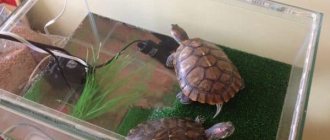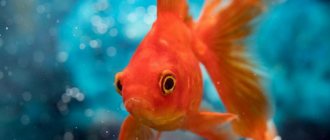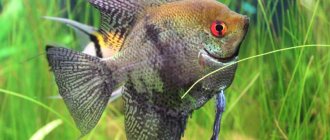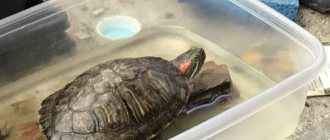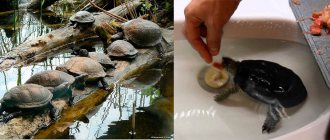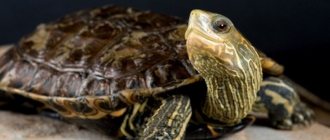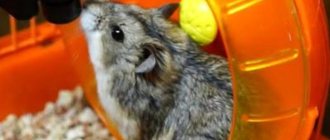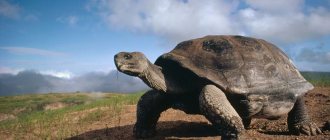- Wild animals
- >>
- Reptiles
The sea turtle is an amphibian reptile belonging to the family Testudines of turtles, and the subfamily Cheloniidae (Sea Turtle) this family includes 4 species: olive turtle, loggerhead, hawksbill, green turtle, Australian green turtle, Atlantic ridley.
Previously this species included the leatherback turtle, but it is now classified in the subfamily Dermochelys. These animals live in seas and oceans all over the world; they cannot be found only in the cold Arctic waters. Sea turtles are good swimmers, swim quickly and can dive deep in search of prey.
Origin of the species and description
Photo: Sea turtle
Sea turtles are chordate animals belonging to the class of reptiles, order turtles, superfamily Chelonioidea (Sea turtles). Turtles are very ancient animals. The ancestors of modern turtles lived on our planet about 220 million years ago.
The ancestors of these amazing animals are the ancient animals cotylosaurs, which lived during the Permian period of the Paleozoic. Cotylosaurs looked like large lizards with wide ribs that formed a kind of shield. According to another theory, the ancestors of turtles were the ancient amphibians discosaurisks.
Video: Sea turtle
The oldest turtle known to science today, Odontochelys semitestacea, lived 220 million years ago during the Mesozoic era. This turtle was slightly different from modern turtles; only the lower part of the shell was formed; it also had sharp teeth. More similar to modern turtles was the turtle Proganochelys quenstedti, which lived about 215 million years ago. This turtle had a strong shell that covered the chest and back of the animal, and there were still teeth in its mouth.
Modern sea turtles are quite large animals. The shell of sea turtles is oval or heart-shaped, covered with horny scutes. Unlike land turtles, sea turtles cannot tuck their heads under their shells due to their short, thick necks. The lower limbs have flippers, with the front flippers being larger than the hind ones.
Almost all their lives, sea turtles lead an underwater lifestyle, and come to land only to create a clutch and lay eggs. Once born, turtles return to the water guided by instinct.
Major diseases
Of all the diseases found in these animals, the most common is pneumonia. Sea turtles do not tolerate drafts very well and can catch cold easily. When observing the first signs of illness (lethargy, refusal to eat), it is necessary to begin treatment. This should only be done under the guidance of a veterinarian and should not be self-medicated under any circumstances. An experienced specialist will correctly prescribe medication treatment. In addition to this course, you can prepare a steam bath with chamomile infusion for your turtle. The steam should be at such a temperature that it does not burn your hand. After holding the animal over the steam for a while, then place it for an hour in a warm bath, one-third consisting of chamomile decoction.
Discharge from the eyes, swelling of the eyelids, soft shell - all this is a serious reason to contact a veterinary hospital.
If you decide to have such an unusual pet at home, you should keep in mind that under favorable conditions, a turtle can live up to 35–40 years.
Appearance and features
Photo: What a sea turtle looks like
Almost all sea turtles have a similar structure. Sea turtles have a large, streamlined shell that covers the back and chest of the turtle. The head is large and does not retract under the shell. The lower limbs are turned into flippers. The front pair of limbs is usually larger than the hind limbs and more developed.
The toes on the limbs are fused into flippers, and only a few toes of the hind paws have claws. The pelvic bones of sea turtles are not crossed with the pelvis. Due to their structural features, sea turtles move very slowly on land, but they are excellent swimmers. The superfamily Cheloniidea includes 4 species of turtles. Depending on the species, turtles have different appearances.
Chelónia mýdas green turtle is a very large turtle. The length of the shell is from 85 to 155 cm; the weight of an adult individual sometimes reaches 205 kg. In very rare cases, the length of the shell can reach 200 cm, and the turtle can weigh up to half a ton. The color of turtles of this species is olive or brown with white and yellow spots.
Eretmochelys imbricata (Hassbill turtle) is similar to, but much smaller than, green turtles. The body of an adult turtle is about 65-95 cm long. Body weight is about 40-60 kg. The shell of turtles of this species is covered with a layer of horny scutes. The shields are tiled-like adjacent to each other. Heart-shaped shell. The back of the shell is pointed. Turtles of this species also have a strong beak. The color of the shell is brown. You can see the yellow spotted pattern.
Lepidochelys kempii Atlantic ridley is the smallest turtle of this family. The adult size is 77 cm, body weight is 47 kg. This species has an elongated triangular head. The color of the carapace is dark gray. This species has sexual dimorphism in favor of females.
Caretta caretta Loggerhead. This type of turtle has 2 claws on its flippers. The carapace is heart-shaped, 0.8 to 1.2 m long, gray-green in color. The weight of an adult is 100-160 kg. Females are also larger than males. There are 10 costal scutes on the turtle's back. The large head of the animal is also covered with scutes.
Lepidochelys olivacea green ridley is a medium-sized turtle with a shell length of 55-70 cm. The body weight of an adult is about 40-45 kg. The shell is heart-shaped. The carapace has four pairs of porous scutes on the lower part of the carapace and about 9 scutes located on the sides. The carapace is flattened on top, the front part is slightly curved upward.
All sea turtles have excellent vision and can distinguish colors. The eyes of sea turtles are located on the top of the head, while the eyes of land turtles are located on the sides of the head.
Interesting fact: The shell of a turtle is so strong that it can withstand a load 200 times the weight of the reptile.
further reading
- Schuler H. G. (2014). Reptiles and Amphibians of Australia, Seventh Edition
. Clayton, Victoria, Australia: CSIRO Publishing. xxx + 1033 pp. ISBN 978-0643100350. - Garman S (1880). "On some species of Chelonioidæ". Bulletin of the Museum of Comparative Zoology at Harvard College, Cambridge, 6
: 123-126.
( Chelonia depressa
, new species, pp. 124-125). - McCulloch AR (1908). "A new genus and species of turtle, from Northern Australia". Records of the Australian Museum 7
: 126-128 + Plates XXVI-XXVII.
( Natator
, new genus, pp. 126-127;
N. tessellatus
, new species, pp. 127-128). - Wilson, Steve; Swan, Gerry (2013). A Complete Guide to the Reptiles of Australia, Fourth Edition
. Sydney: New Holland Publishers. 522 pp. ISBN 978-1921517280. - Zangerl R, Hendrickson LP, Hendrickson JR (1988). "A redescription of the Australian flatback sea turtle Natator depressus
".
Bishop Mus. Bull. Zool. 1
: 1-69.
( Natator depressus
, new combination).
Where does the sea turtle live?
Photo: Sea turtle in the water
Sea turtles can be found in oceans and seas around the world. These animals are not found only in cold Arctic waters. Green turtles inhabit tropical areas of the world's oceans. Most of these animals can be found in the Pacific and Atlantic oceans. Hawksbill turtles choose places with a temperate climate to live. They live in the waters of the Black Sea and the Sea of Japan in the area of Nova Scotia and Great Britain.
These animals can also be found in southern Africa, in the waters of New Zealand and Tasmania. Hawksbill turtles are capable of long migrations, and make them during the breeding season. Turtles of this species nest on the shores of Sri Lanka and the Caribbean Sea.
They may nest on the shores of Turkey. The Atlantic Ridley inhabits the Gulf of Mexico. These animals can be found in southern Florida, Great Britain, Bermuda on the coasts of Belgium, Cameroon and Morocco. It usually lives near the shore in shallow water, however, during hunting it can dive to a depth of 410 meters and remain under water without oxygen for up to 4 hours.
Loggerhead turtles live in the waters of the Pacific, Atlantic and Indian oceans. They live in places with a temperate climate. For nesting, they make long migrations to places with a warm tropical climate. They usually come to Maskira Island in Oman to nest.
Nesting sites are also known in Australia and the Dominican Republic. Olive turtles prefer the waters of the Indian and Pacific Oceans. Sea turtles spend their entire lives in the water; only females come ashore to lay eggs. After the clutch is formed, the turtles immediately go back into the water.
Interesting Facts
- In some Eastern mythologies, such as Chinese, the turtle represents one of the four main characters. Along with the dragon, qilin (a mythical creature with several horns, the body of a horse, a dragon's head and a bear's tail) and the phoenix, it often appears in legends as a wise and benevolent animal.
- In ancient times, it was generally accepted that the turtle was the basis of the universe. The model of the world was depicted in the form of this animal. Three elephants stood on her back, and they, in turn, held the Earth on their backs, which seemed almost flat.
- Sea turtles are such outstanding swimmers that local populations choose them as mascots or specimens. For example, the famous swimmers from the island of Fiji bow their heads with respect before the outstanding swimming qualities of these animals, and it was on this island that the marine department chose them as their symbol.
- Turtles, spending their entire lives in the sea, always strive to return to their birthplaces to continue their offspring and unerringly find them. They build navigation based on the magnetic field of our planet, which helps them not to wander in the open sea.
- In philosophy, there are paradoxical reasonings - aporias, the author of which is the ancient Greek philosopher Zinon. One of them says that the fleet-footed demigod Achilles will never catch up with the tortoise. Its essence is that space and time are infinitely divisible; there is always a part of the path left that the turtle managed to overcome, but Achilles did not. This is a false idea, and it constitutes this paradox. We touched upon this issue only so that the reader can understand where the reference to the aphorism “Achilles and the Tortoise” is found in some famous literary works.
What does a sea turtle eat?
Photo: Large sea turtle
Most sea turtles are dangerous predators.
The diet of sea turtles includes:
- seaweed;
- plankton;
- crustaceans;
- shellfish;
- fish;
- snails;
- shrimp and crabs.
Interesting fact: Green turtles are predators only during the first years of their lives; as they age, they switch to plant foods.
Sea turtles hunt in different ways. Most wait for their prey in algae thickets for a long time and then suddenly attack. Some turtles use their tongue as bait, exposing it and waiting for the fish to swim up to it to grab it.
Sea turtles are able to swim quickly and dive to great depths for prey. Sea turtles have been known to attack some waterfowl, but this is rare. Among some species of turtles, cases of cannibalism have been reported; large turtles attack juveniles and small turtles.
Small sea turtles are often kept as pets. In captivity, a sea turtle is fed meat and various offal, chicken, insects, fish, shellfish and crustaceans; it is also necessary to ensure that there is a lot of vegetation in the aquarium; turtles love to eat algae.
When feeding, meat and fish must be cut into small pieces, removing the bones. Once a month they give additional vitamin and mineral supplements, chalk, and eggshell powder.
Lifespan
Turtles are truly long-lived even by our human standards, because they live many times longer than us humans. So the average life expectancy of turtles in natural conditions can be 180-250 years.
The oldest turtle in the world, named Jonathan, lives on the island of St. Helena and remembers (probably) the times of Napoleon, because the former emperor of France lived here in exile for some time.
Features of character and lifestyle
Photo: Leatherback turtle
Sea turtles have a calm nature. They are leisurely, although they are capable of swimming quite quickly and well. Sea turtles spend their entire life in water. Turtles stay in shallow water near the shores, however, when hunting they can dive deep into the water and stay there for a long time.
All sea turtles make long migrations in order to have offspring. No matter how far turtles are from the warm tropical shores where they were once born, when the time comes, they return there to lay eggs. In this case, one turtle always forms a clutch in the same place. Turtles breed at the same time and on the shores during the breeding season you can see hundreds of females laying eggs.
The social environment of sea turtles is undeveloped. Turtles most often live alone. Young turtles, hiding from predators, spend almost all their time in algae thickets, where they can feel safe. Older turtles swim freely in the water. Sometimes sea turtles like to bask in the sun by climbing on rocks.
Under poor environmental conditions and lack of food, sea turtles are capable of falling into a kind of suspended animation. At this time, turtles become lethargic and eat little. This helps turtles survive during winter. In winter, turtles sink to the bottom and can live anaerobically for a long time without swimming to the surface.
Hibernation
Yes, turtles, like
Bears and some other animals tend to hibernate, during which all life processes in their body slow down for a while. This usually happens in winter, and hibernation for heat-loving turtles living in temperate latitudes allows them to survive the winter cold without problems.
Social structure and reproduction
Photo: Sea turtle in the sea
Sea turtles breed in warm tropical waters. Mating takes place in shallow water next to the sandy shore. Males choose a female and swim directly to her face. If the female is ready and does not reject the partner, mating occurs, which lasts several hours. Males do not show aggression towards females, but females, on the contrary, can bite an unwanted suitor.
After mating, the female climbs ashore and lays eggs. The female forms a clutch by digging a deep hole in the sand. In this case, the masonry can be located in the most unexpected places in the middle of the beach, or on the side of the road. The female makes a deep excavation in the sand up to half a meter deep. The female lays eggs in the hole. There are about 160-200 eggs in one clutch. After the clutch is formed, the female leaves the clutch and never returns to it. Parents are not interested in the fate of their offspring.
Interesting fact: The sex of the future offspring depends on the temperature of the sand in which the eggs are buried. If the sand is warm, females will hatch; at low temperatures, males will hatch.
After a few months, tiny turtles are born. When the time comes for the babies to be born, they break the egg shell with an egg tooth and climb to the surface. Little turtles instinctively crawl towards the sea. However, many predators await the cubs on the shore, so not all of them make it far to the water. In the water, small turtles are forced to lead a secretive lifestyle for a long time, hiding in algae thickets from predators. Turtles become sexually mature at approximately 30 years of age.
Video
And finally, here is an interesting documentary about turtles.
Author: Pavel Chaika, editor-in-chief of Poznavaika magazine
When writing the article, I tried to make it as interesting, useful and high-quality as possible. I would be grateful for any feedback and constructive criticism in the form of comments on the article. You can also write your wish/question/suggestion to my email [email protected] or Facebook, with respect, the author.
Author page
Natural enemies of sea turtles
Photo: Green sea turtle
Despite the turtles' natural defense - a strong shell - sea turtles are very vulnerable creatures. Most sea turtles die in early childhood and the mortality rate at this stage is about 90%.
Natural enemies of sea turtles are:
- large sharks;
- fish;
- dogs;
- raccoons;
- seagulls and other birds;
- crabs.
Only sharks are dangerous to adult turtles. Clutches can be destroyed by many predators; on land and in water, juveniles can be attacked by birds, dogs, and predatory fish. During bad weather conditions, many turtle hatchlings often die in turtle breeding areas. They either do not hatch at all due to too low or, conversely, high sand temperatures, or they die after hatching and getting ashore in bad weather.
But the main enemy for sea turtles is humans. People catch sea turtles because the meat of these animals is used for food, and the shell is used to make jewelry, jewelry boxes, and many home decoration items.
Water pollution has a very negative impact on the population of sea turtles. Often, sea turtles mistake garbage and polyethylene and pieces of plastic for edible jellyfish and die due to ingestion of inedible objects. Many turtles get entangled in fishing and shrimp nets, which is why they also die.
Interesting fact: Some species of turtles consume poisonous shellfish as a form of self-defense, while this does not harm the turtles themselves, but the meat of the turtle becomes poisonous and this scares off predators.
Keeping at home
Keeping turtles at home has recently become very popular, both land and aquatic turtles are kept. And why not, because caring for them is extremely simple, and turtles themselves are unpretentious creatures. True, all of the above is true for small turtles, since keeping large turtles in the house will not be entirely appropriate.
So, what are the rules for caring for turtles? First, in the turtle's habitat, you need to keep a thermometer to monitor the air temperature and a thermometer to monitor the water temperature (if it is an aquatic turtle in an aquarium).
The water in an aquarium for turtles must either be purified using filters, or if there are none, then changed every day. Maintaining hygiene for aquatic turtles involves removing algae from their shells. But land turtles need to be bathed daily in warm water, washing away dirt and food debris. Also, in winter, it is advisable to irradiate turtles a little with the rays of a quartz lamp, thus creating a kind of sunbathing.
Population and species status
Photo: What a sea turtle looks like
Sea turtle population numbers are extremely difficult to track due to the fact that turtle populations are so scattered and turtles migrate long distances. However, it is known that due to human activities, the population of sea turtles has greatly decreased. First of all, the decline in the population of sea turtles is caused by the ruthless hunting of these creatures in order to obtain meat and valuable shells.
The arrival of civilization and the development of beaches in turtle breeding areas also had a negative impact on the population of sea turtles. Many turtles are afraid of noise, electric lighting and large numbers of people on the beach and simply do not come ashore to form clutches. Many turtles die after being caught in fishing nets and swallowing debris floating in the water.
At the moment, most species of sea turtles are listed in the Red Book as endangered species and particularly vulnerable species. Hawksbill turtles are almost completely extinct, so hunting them is prohibited throughout the world. However, there are black markets where poachers sell turtle eggs and turtles of this species and the demand for them continues unabated. All over the world, measures are being taken to protect rare species of turtles to restore the populations of these animals.
Do you know?
- All but one species of sea turtle are threatened with extinction.
- The sea turtle feeds on sea grass, algae, crabs, shellfish and sponges.
- The largest sea turtle is the leatherback turtle. This species of turtle has been recorded to be able to dive to depths of over 3,280 feet (1,000 m).
- All turtle species migrate at least short distances, from their foraging site to their nesting site and then back again. Some species of turtles travel up to 1,560 miles (2,600 km) in the open ocean.
- The most popular nesting turtle species in the United States are snapping turtles, which nest on the beaches of the southeastern states.
- All female sea turtles lay their soft, spherical, white eggs on beaches in a nesting hole that they dig using their back swim membranes.
- Newly hatched turtle fry make their way up with their paws, appear on the surface and immediately rush into the ocean. This usually happens at night.
- Threats to sea turtles include destruction of beaches where turtles nest, poaching (hunting for turtle eggs), drowning in fishing nets, and predation by birds and mammals.
conservation
Status
An example of gills that pose a threat to flatback sea turtles.
Flatback sea turtles are listed as vulnerable nationally in Australia. This is the least dangerous of all sea turtles. Unlike other sea turtles, there is not much human demand for meat in FlatBack sea turtles. He doesn't swim far from the shore; This way, it doesn't get caught in nets as often as other sea turtles. These reasons may contribute to why it is not in greater danger of extinction.
Threats
All sea turtles face threats such as habitat loss, wildlife trade, egg harvesting, meat harvesting, bycatch, pollution, and climate change. Flatback sea turtles are specifically threatened by the direct collection of eggs and meat by Australia's indigenous peoples for traditional hunting. These people received the right to procure the government, but only if for non-commercial purposes. Another threat is the destruction of nesting beaches due to coastal development and destruction of feeding areas on coral reefs and shallow waters near the shore. Camping on these beaches compacts the sand and promotes dune erosion and wheel ruts caused by vehicles driving on the beaches can waylay chicks on their way to the sea. Coastal development promotes barriers that make it difficult or impossible for adult turtles to reach nesting and feeding grounds. Flatback sea turtles also fall victim to accidental capture. Caught by fishermen, especially trawling, gillfishing, ghost nets and crabs. Finally, environmental pollution is a problem for these creatures. Pollution can affect the timing of egg laying, how it selects its nesting site, how hatchlings find the sea after emerging, and how adult turtles find beaches.
Saving methods
In 2003, a recovery plan was put in place on a national level to help this species along with other sea turtles. This plan aims to reduce mortality rates within commercial fishing and ensure sustainable harvests for indigenous people. Monitoring programs are developed and integrated, along with management of factors that influence the reproductive success of the species. In Kakadu National Park, a monitoring program has already been established for this species. Critical habitat for this species is currently designated for protection. People are also trying to improve communication about information about FlatBack sea turtles, as well as increasing cooperation and action internationally.
Rivalry
Males fight fiercely for the right to mate with a female. Land turtles hit their shells against each other so that the enemy ends up on their backs or runs away.
Sea representatives pursue their rivals and gain the upper hand with menacing blows of their strong beak, forcing competitors to leave the battlefield.
Exhibitions
Meetings with living representatives of sea turtles in the collections of aquariums and zoos allow the public to learn a lot of interesting things about the life of these beautiful animals and how human activities can affect their survival.
In the protected environment of marine aquariums, scientists can study aspects of sea turtle biology that are difficult or impossible to study in the wild. Thus, in June 2003, aquarists at SeaWorld San Diego incubated 21 green sea turtle eggs in an artificial environment for the first time.
More and more oceanariums are appearing in Russia and there is hope that the efforts of their creators will help preserve endangered animal species, including sea turtles.
Photo by Nikolay Safonov
Materials used: https://en.wikipedia.org/ https://ecos.fws.gov/ https://www.iucnredlist.org/ https://animaldiversity.ummz.umich.edu/ https://www .turtles.org/ https://seaworld.org/ “Aquarium Inhabitants” You can download some photos of sea turtles for use as computer desktop wallpapers in 1920 x 1080 resolution
Once the image is open, hover over it, right-click and select “Save Image As”
taxonomy
The flatback sea turtle was originally described as Chelonia depressa
in 1880 by the American herpetologist Garman.
The genus Natator
(meaning "swimmer") was created in 1908 by Australian ichthyologist Allan Riverstone McCulloch, and in the same scientific work he described what he considered a new species,
Natator tessellatus
, thereby creating a junior synonym.
In 1988, Swiss paleontologist Rainer Zangerl assigned FlatBack sea turtles to the genus Natator
as a new combination
Natator depressus
.
Because Chelonia
is feminine, and
Natator
is masculine, the specific name was changed from
depressa
to
depressus
.
Notes
- What determines sex in turtles? // Ecology. - Rusich. — P. 30-31. — (Educational encyclopedia). — ISBN 5-88590-897-4.
- Ananyeva N. B., Borkin L. Ya., Darevsky I. S., Orlov N. L.
Five-language dictionary of animal names. Amphibians and reptiles. Latin, Russian, English, German, French. / under the general editorship of academician. V. E. Sokolova. - M.: Rus. lang., 1988. - P. 142-143. — 10,500 copies. — ISBN 5-200-00232-X. - IG Danilov, AO Averianov, and AA Yarkov. 2010. Itilochelys rasstrigin gen. et sp. nov., a new hard-shelled sea turtle (Cheloniidae sensu lato) from the Lower Palaeocene of Volgograd Province, Russia. Proceedings of the Zoological Institute RSA 314(1):24-41
